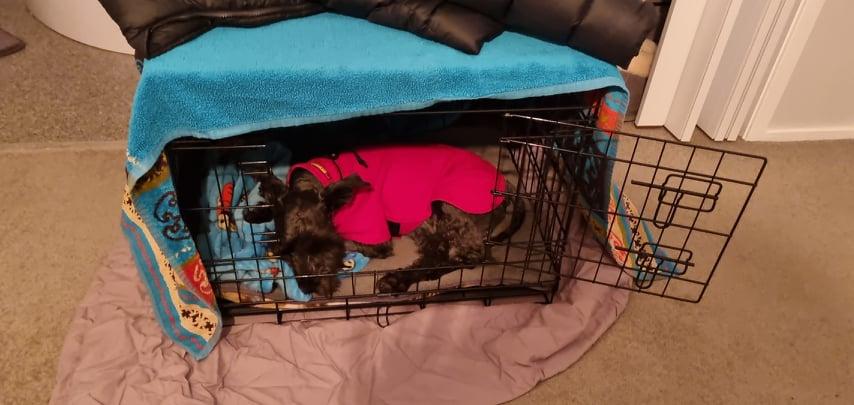You’ve just been given a diagnosis for your dog: Fibrocartilaginous Embolization (FCE). What exactly is this condition and how is it treated? Read on to learn more about the symptoms, treatments, and prognosis of FCE in dogs.
What Is Fibrocartilaginous Embolization (FCE)?
FCE is a medical condition that occurs when the blood supply to the spinal cord is cut off by a piece of fibrous cartilage.
The medical community doesn’t yet know what causes FCE. It is believed that the fibrous cartilage comes from intervertebral discs (IVD). IVD is what gives the spine support and stability. These discs are made up of an inner nucleus pulposus and an outer annulus fibrosus. The general consensus is that the fibrous cartilage leaves the nucleus pulposus and enters the blood vessels, causing the FCE.
Essentially, an FCE is a spinal cord stroke. When the blood supply is cut off so is the oxygen supply to the spinal cord. The result is a loss of function in one or more limbs.
Dog Breeds Most Commonly Diagnosed With FCE
Although FCE can occur in any breed, it occurs most commonly in large breed dogs (e.g. German Shepherds, Boxers, and Labradors). While not as common in small breed dogs, miniature schnauzers were the single most reported breed in a 2016 Systematic review. Shelties that have been diagnosed with hypothyroidism also appear to be at higher risk, as do Irish Wolfhound puppies.

FCE can occur at any age but is most commonly diagnosed in middle-aged pets.
What Are The Symptoms Of An FCE in Dogs?
The symptoms of an FCE typically begin during strenuous activity, like running and jumping. The majority of dogs will yelp once and then seem to be without pain but will suddenly lose the ability to use one or more limbs, depending on what section of the spinal cord is affected.
Typically, the FCE occurs in the middle part of the spinal cord, resulting in paralysis in the hind legs, however, it can occur in the neck and affect all four legs. Symptoms occur rapidly and generally do not worsen after 24 hours.
How Is FCE in Dogs Diagnosed?
Your veterinarian will perform a full neurologic exam and will then typically recommend a diagnostic full diagnostic workup. An FCE has similar symptoms to other spinal cord conditions such as IVDD and it’s important to rule out all potential causes. Tests like bloodwork, x-rays, a CT scan, myelogram, and MRI may be ordered.
Sedation is generally required during these tests as it’s very important for the dog to remain perfectly still so a clear image can be obtained.
How Is An FCE in Dogs Treated?
At this time, there is no specific surgical treatment available for dogs with an FCE. Medical specialists have not yet discovered a way to remove the fibrocartilage from the spinal cord blood vessels.
In the time immediately following the onset of symptoms, supportive care needs to be provided. It’s best to keep the dog on a well-padded bed, rotating them from side to side every four to six hours to prevent bedsores. A urinary catheter or manual expression of the bladder may be required if the patient is unable to relieve themselves. Corticosteroids may be prescribed.
In addition to supportive care, rehabilitation is key during this initial phase to help facilitate recovery. Rehabilitation may include stretching exercises, assisted exercises, muscle stimulation, and hydrotherapy.
Rehabilitation goals include:
- Maintaining soft tissue flexibility;
- Preventing muscle wasting/atrophy;
- Improve core stability;
- Improving body awareness and coordination;
- Improve gait;
- Improve cardiovascular fitness.
Dogs should start rehabilitation as soon as possible.
The hope is that these therapies will encourage other blood vessels to open, facilitating additional blood circulation in the spinal cord and eliminating or reducing symptoms.
Assistive devices like a sling, walking cart, or harness with a handle are excellent tools for owners to consider.
The Prognosis For Dogs Diagnosed With FCE
The prognosis does depend on the location of the FCE, the amount of spinal cord that has been affected, and the severity of neurologic dysfunction. If deep pain, which is a physical reaction to painful stimulation, is present, the prognosis is generally good with a >85% return to function.
While some dogs recover rapidly over just a few hours or days, others may see slow and steady improvement over 2-6 weeks. In the most severe cases, little to no improvement may be seen. The good news is that the majority of dogs are able to recover the ability to walk, although there may be permanent neurological deficits.
Do I Need To Worry About A Second FCE?
The good news is that FCE does not recur in the vast majority of dogs!

